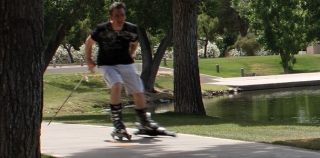These were likely the same considerations that Doug Lucht, founder of StreetSki, faced until he found a way to combine his passion for skiing with the versatility of inline skates. But how does this work?
It's often said that one of the best training sports for skiing is inline skating because the body movements and positions are very similar. If we modify a skate to respond as closely as possible to a ski, we get a StreetSki. The solution was to extend the wheel frame to about 70 centimetres (depending on the model) and fit it with conventional ski bindings. This is crucial as it allows you to use your regular ski boots, providing nearly identical sensations.

The main benefits, beyond general cardiovascular improvement, involve the specific use of technique and muscle groups that we'll later use for skiing, helping reduce the risk of accidents common at the start of the season due to poor physical condition. It's also ideal for "breaking in" new boots before hitting the slopes, saving several days of adaptation and even allowing modifications to the shell or liner to prevent future discomfort.
Moreover, you're not dependent on snowfall, don't need to travel long distances, or pay expensive lift passes. You can use them on any surface, paved or not, flat or sloped, with or without poles. Suitable for all ages, it's truly an invention designed by skiers for skiers.
The speed you can reach is no joke either. In downhill competitions, speeds of 80 kilometres per hour are common, though the first speed record, held by Doug Lucht, stands at 101 kilometres per hour!, earning him a place in the Guinness Book of Records. Interestingly, he set this record in 1998 on his 30th birthday.

Models
All feature 80-millimetre wheels with 78A hardness, though downhill and all-terrain models have specialised wheels. They come standard with Marker 28 bindings, with colours varying by model.
- StreetSki Slalom. Designed for short turns, it has a much lighter, shorter design (70 centimetres versus 87 in other models), aggressive and easy to handle. By far the best-selling model.
- StreetSki Giant Slalom. Its six wheels provide stability at high speed, further enhanced by its greater length. Can be fitted with all-terrain wheels.
- StreetSki Downhill. Built to reach maximum speeds. Comes factory-fitted with Hyper Shock competition wheels tested by Team StreetSki at over 95 kilometres per hour.
- StreetSki Extreme Terrain. Originally designed for summer ski resort lifts used by mountain bikes. Features special off-road wheels and a highly flexible frame.
- How do you go uphill?
- How do you brake?

- Protective gear?
- Is it hard to learn?
As with everything in life, know your limits. Like skiing, the perfect slope is where you feel comfortable. Most start on flat ground to master the basics before gradually increasing difficulty.
Consider this: the average skier skis about 10 days per year. With StreetSki, you could ski the remaining 355.
















